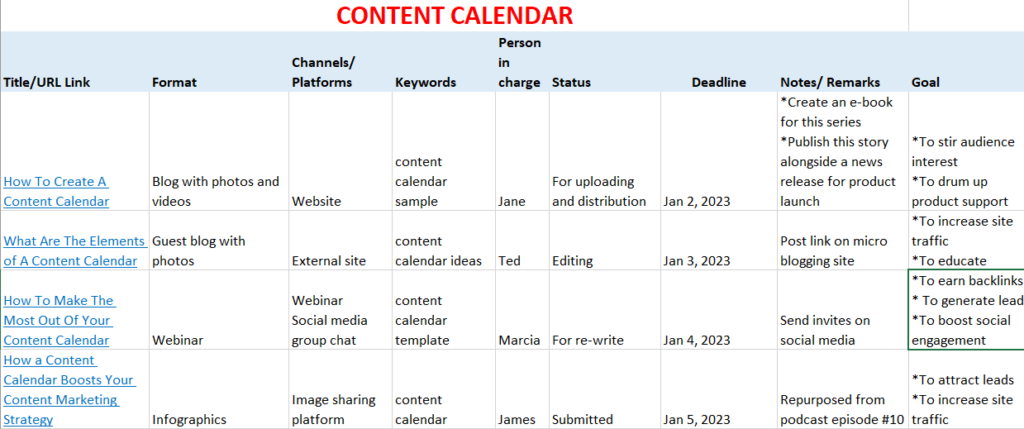Every individual who has participated in a competition, taken an exam, or held a job recognizes the mantra that suitable preparation prevents poor performance. This principle holds true universally, including for marketers and content creators.
With numerous activities concurrently unfolding, it can be challenging for content, marketing, and search engine optimisation (SEO) teams to maintain an oversight on their campaigns and content creation processes. Teamwork becomes indispensable in this scenario because these units need to collaborate effectively to excel.
Establishing a content calendar can infuse order into this organisational turmoil by fostering enhanced planning and cooperation. Populating the calendar with content and distribution details, along with interdepartmental activities, simplifies the process significantly. To streamline this process, partnering with a digital agency in Melbourne could be immensely beneficial.
Whether you're planning to start the next year with a content calendar or want fresh ideas, you've come to the right place. Reading this article, you’ll gain more understanding about a content calendar, its essential elements and the best practices in making one.
Defining The Content Calendar

A content calendar is a visual representation that allows you to plan your digital content within a specific period. It enables team members to view, share, and update the entries for a more organised and collaborative workflow. A content calendar ensures you have a steady flow of digital assets and can run multi-channel marketing campaigns more comprehensively.
Does a Content Calendar Really Help?
Content can impact your audience in several ways. With it, your team can inform, educate, entertain and persuade readers to convert. With the right strategies, a brand's digital assets can attract and generate leads, explain the added value of your products and services and find revenue opportunities in general.
But what happens before and during the creation stages are the most difficult and time-consuming stages in the workflow. Filling out a content calendar template or customising the design can help you because it streamlines the content creation process and facilitates more comprehensive marketing activities.
Essential Components of a Content Calendar Template
There's no right or wrong way to create a content calendar. More entries don't necessarily make it better, while a too-simplistic template may cause missed opportunities for collaboration and performance monitoring. While you can get a content calendar template for free, you may consider downloading software for easy integration with other business platforms.
The right approach would be to know which components are essential to your operational objectives. Below are some of the common entries found in a content calendar template.
- The content's title (current and upcoming)
- Content URL
- Content format/type
- Content goal
- Channel(s) for publication and distribution
- Person in charge/ content creator
- Content status updates
- Remarks (i.e. other related promotional activities)
Revisit your content calendar template often and see whether it fulfils your requirements. If not, don't hesitate to tweak and modify its components.
Here's a content calendar example:

Why Create a Great Content Calendar
Content calendar creation can be as simple or as complex as you want. Nonetheless, understanding why you're creating one is necessary. Knowing your purpose, as below, helps you create a content calendar template that suits your requirements.
1. To stay organised and efficient

Marketing encompasses different strategies, all working to grow your business across various channels. An overall view of ongoing and future activities ensures plans are properly executed, and content production schedules are complied within and out of your organisation.
Besides minimising the risk of errors, it's also easier to identify certain milestones that require more effort, like a product launch or other promotional event. Similarly, creating and updating a content calendar enables flexibility in output and lets you make urgent changes. That said, it must be updated and shared regularly to the concerned individuals or departments
2. To consistently create high-quality and relevant content
To stay on your audience's radar, it's crucial to be consistent in all aspects, particularly in content quality and quantity. According to Semrush's 2022 The State of Content Marketing Global Report, 55% of marketers attribute improved content quality and search engine optimisation (46%) to their success.
Keeping a schedule ensures a steady stream of content across all platforms. Uploading resources on time sends your audience positive signals of trustworthiness and reliability. Keeping your schedule regular enhances customer experience, which is crucial as up to 91% of consumers are more likely to go for a second purchase after a positive customer experience, according to a 2020 Salesforce global survey.
3. To identify gaps and opportunities
Striving for consistency also means not losing sight of other opportunities, like producing a new range of topics and emerging content types. For instance, according to a HubSpot survey, videos were the leading content format used by marketers in 2021, with blogs, images and infographics rounding the top four.
Brands are also turning to audio content formats like podcasts, especially for US consumers. The same survey found that 51% of those currently using the channel will invest the same amount or more in the coming year. There's a growing interest in audio chat rooms too.
Simply put, a calendar helps stimulate content ideas and assists your team in producing the right content formats and on the right platforms that match the audience preferences accurately.
4. To constantly improve performance
Having a content calendar lets you monitor team members and campaign performance. It impacts staff accountability because the table indicates individual deliverables within a certain period. Meanwhile, the visual tool can include key performance metrics alongside content goals. For instance, measure the traffic sources, conversion rates, click-through rates and new visitors if your content goal is to increase web traffic. Using analytics helps determine the efficacy of your unique content and the other content marketing strategy components.
Gathering these results is valuable before making the necessary changes to your calendar, content production goals and marketing tactics to push for better performance and revenues.
What does it Take to Create a Great Content Calendar?

After learning the purpose and components of a content calendar comes the interesting part: how to make one.
Again, there's no single or best method to create a content calendar. But some software tools may suit your needs better than a content calendar template in an excel spreadsheet. Brands implementing simple campaigns often use spreadsheets and virtual calendars, while more complex plans often require automated solutions that allow integration with other tools.
Below, you'll find the essential success factors and actionable steps in making a content calendar.
Content calendar success factor #1: Promoting organisational efficiency
Grooming the SEO, content and marketing teams towards success demands that each member knows the deliverables. They must know how to perform their tasks and why.
1. Set clear content goals
Knowing why you're crafting content is imperative before making any plans. Doing so makes the entire marketing campaign homogenous and more impactful. According to Semrush's 2021 State of Content Marketing survey, 45% of marketers aim to increase brand awareness, 37% hope to raise web traffic and 36% want to get more leads through content creation and distribution this year.
Having clear content objectives affects your creation and marketing process entirely. For instance, writers can determine which tone, style and format to use, and the marketing team can identify the best channels to share the content.
2. Establishing streamlined workflows
Team members must have clear deliverables and should stick to pre-set timelines. There should be no question as to who does what. Take a look at this chart as an example:

3. Keeping everyone on the same page
Provide your team members with all the resources they need to facilitate efficiency. Hand out strategy and style guides, provide them access to content management software and share best practices, workflows and more.
4. Conducting regular meetings
Schedule regular meetings with the editorial team, marketing, SEO and other units involved. These regular discussions shouldn’t only focus on planning and ensuring enough supply in your repository but to present challenges and results, revisiting plans and revising them as needed.
Content calendar success factor #2: Helping produce high-quality and relevant content
Creating a content calendar must enable you to provide a steady stream of relevant and engaging content, providing your audience with a positive experience. Here are some tips for keeping them engaged and wanting more.
1. Topic creation: Knowing what your audience wants and how to hook them
Understanding your customers is the key to creating content that resonates with them. Review the marketing funnel and study each buyer persona in the different stages. Imagine which topics will appeal to them, whether they're still thinking about buying, are ready to purchase or have decided to go through with the transaction.
2. Social listening
This vital marketing and content creation process, also referred to as social media listening, entails scanning the internet for brand mentions and analysing the audience's perceptions. With it, companies can gauge brand awareness, consumer impressions and sentiments. It's also being utilised for data mining , focusing on specific keywords and boosting your SEO efforts.
Alongside surveys and interviews, social listening is used as a customer intelligence channel. According to Social Media Today's the State of Social Listening 2022, almost 61% of businesses have it in place, while 82% use it as a primary planning consideration.

3. Topic clusters
Multiple content pieces can be culled from a single topic and other related subtopics, otherwise known as a topic cluster. Notice the content calendar example above? They all talk about the content calendar. However, readers have different questions about the specificities of a content calendar, and the most basic questions are divided into four sub-topics in every reader's mind.
4. Identifying content distribution channels and posting schedules
Deciding which platforms to upload and share your content and the posting frequency depend on multiple factors, including:
- The content type or format
- The channel (i.e. website, social media, email, etc.)
- Your audience and target market
- Your available resources (staff and materials)
Some platforms work best for a specific purpose. For instance, your website is best for uploading gated content, how-to videos and interesting information about your business or industry niche. Video-sharing platforms are better for webinars and educational videos, while social media platforms are great for building brand awareness and product features.

Another thing to consider is that online videos have the widest global reach, covering 93% of internet users. Various companies have been using these for different purposes, including tutorials and product reviews, according to Statista. This data corroborates Semrush's Content Marketing survey, which saw video production as a key marketing investment in 2022.
So how many posts should you make? There's no one-size-fits-all answer to this question, and the jury is still out on whether daily blogging generates better results. Besides distributing high-quality content, posting time and frequency impacts user engagement, especially in social media channels.
If you're making a content calendar for social media, you might consider the following recommended posting frequencies, per digital imaging software company Adobe.com.
5. Determining the best content mix
Marketing campaign success requires identifying the best marketing channels and tailoring your creation accordingly. In generating leads, for example, the leading media platforms are emails, social marketing and SEO, according to Gartner. The key to making these activities effective is to craft the right messages by understanding what your audience wants.
Content calendar success factor #3: Identifying gaps and opportunities
Besides freeing your staff from repetitive manual tasks, marketing automation serves a more important purpose: benchmarking. Thanks to data analytics, you can monitor not only your performance but your competitors as well. Analysing how other companies run their marketing campaign enables you to identify the best practices, gaps and opportunities.
1. Study the most popular content in your niche
Get inspired with more content ideas by looking at the various content that impacts your industry and making it better. For instance, if you're a software as a service (SaaS) provider for a famous social media platform that recently announced some updates, you can write content explaining how these changes will impact your customers.
Studying other companies' high-performing content likewise provides insights into the subjects that interest your audience and the type of format they love to consume.
2. Monitor other brands' campaigns
Similarly, study how industry leaders run their content marketing strategy and identify areas for improvement. Some software and search engine optimisation tools have built-in analytics for analysing content performance in single or multiple channels.
Besides data analytics, you can also get insights from news agencies. For example, the Balenciaga advertisement scandal was picked up by major publications, though not in a positive light. On the contrary, it has taught fashion brands to be more sensitive in their marketing drives, especially those involving children.

3. Take a look at your existing digital and non-digital assets
Uploading fresh content can be a challenge in the long term, especially if you're regularly uploading online materials. In creating topics for the content calendar, consider your available resources and how you can repurpose or refresh your content. This means you don't have to start from scratch every time. For example, long-form content can be divided into smaller and more digestible chunks by creating infographics. An interesting research finding can be repurposed as a news article, while any of your business executives can be a subject matter expert.
4. Integrating promotional activities
Your content calendar must include information on content promotion and other marketing activities related to it. Planning other promotional activities and placing them on your calendar helps you organise and improve your marketing campaigns to get maximum results.
This is especially true when reaching out to other businesses for cross-promotional initiatives. Messing up a marketing partnership is a costly mistake that can hurt your reputation and revenue opportunities.
Content calendar success factor #4: Constantly seeking improvements
One good thing about maintaining a content calendar is that the entries can be revised or moved depending on the specific circumstances. Regular reviews are necessary to ensure that your overall marketing campaign works and can be tweaked for significant or minor enhancements.
1. Track content performance
Tracking the content's performance after the content distribution is vital in understanding which topics and formats work best for your audience. Various metrics can be used to measure performance depending on the content objectives. For content that wishes to increase web traffic, look at SEO ranking changes, page views, new subscribers, click-through rates and other user behaviour indicators on your site or page.
The results of such data provide the cornerstones for your plans. Identifying which topics gained the most traction and in which channels provide you with valuable insights on where to post and which content types attract the most engagements. Knowing what makes content engaging and useful to your readers allows you to create more interesting content in the long term.
2. Update and review your plan
Planning helps you organise your content calendar better. But the time consideration will depend on factors related to your company, content guidelines and industry niche, among other things. Some prefer to plan a year ahead, while others prefer to plan quarterly, bi-annually or monthly.
Nonetheless, filling up your content calendar in advance gives you enough time to make the necessary revisions crucial to strategic success.
The takeaway
A content calendar is a flexible tool that enables teams to plan better and work more efficiently. Besides scheduling future digital asset production, a good calendar must ensure the quality and relevance of each resource through constant review and revision, as can be gleaned from the discussion above.
Despite its variable nature, or perhaps because of it, creating a content calendar is critical in your overall marketing strategy, regardless of your chosen content, type and distribution platform.
As a primary content management and distribution tool, it allows teams to stay on track despite directional changes. Because of its value in the entire marketing strategy, a content calendar can help steer the company in the right direction. Think of it this way: If the content is the king and consistency is the queen, the content calendar is the royal advisor.
